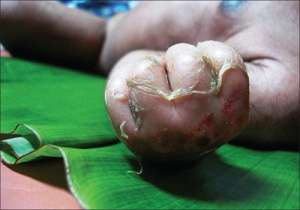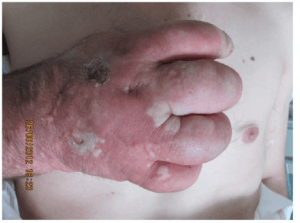Staphylococcal scalded skin syndrome
Background
- Caused by Staph aureus
- Most patients <2yr old, nearly all <6 yr old
Clinical Features

Infant with Staphylococcal scalded skin syndrome

Differential Diagnosis
- Erythema Multiforme
- Staphylococcal scalded skin syndrome
- Erythroderma
- Toxic Shock Syndrome
- Drug rash
- Pemphigus vulgaris
Erythematous rash
- Positive Nikolsky’s sign
- Febrile
- Staphylococcal scalded skin syndrome (children)
- Toxic epidermal necrolysis/SJS (adults)
- Afebrile
- Febrile
- Negative Nikolsky’s sign
Evaluation[1]
- PCR for toxin if available
- CBC - leukocytosis, though normal WBC level oftenly
- ESR elevation
- Monitor electrolytes, renal function closely in severe disease
- Blood cultures variably positive (more often pos in adults)
- CXR to rule out pneumonia
Management
- Often requires inpatient therapy, Fluid Resuscitation, parenteral antibiotics
Antibiotic Options
- Nafcillin 100mg/kg/d IV in 4 divided doses OR 50mg/kg/d in 4 divided doses PO x7-10d
- Penicillin G Procaine (300K U/d IM for <30 kg, 600K to 1 million U/d IM for >30 kg)
- Amoxicillin/Clavulanate 45mg/kg/d PO in 2 divided doses x 7-10d
- Cefazolin 100mg/kg/d IV in 4 divided doses
- Cephalexin 40mg/kg/d in 4 divided doses x 7-10d
- If possible MRSA:
- Clindamycin 40mg/kg/d IV or PO in 4 divided doses x7-10d
- Bactrim 10mg/kg/d in 2 divided doses x7-10d
- Vancomycin 10-15mg/kg/d in 2 divided doses up to 1 gm q12hr
Disposition
- Transfer to burn center if diffuse
- Localized infection may discharge home with follow up
See Also
References
- Randall WK et al. Staphylococcal Scalded Skin Syndrome Workup. eMedicine. Oct 28, 2015. http://emedicine.medscape.com/article/788199-workup.
This article is issued from
Wikem.
The text is licensed under Creative
Commons - Attribution - Sharealike.
Additional terms may apply for the media files.